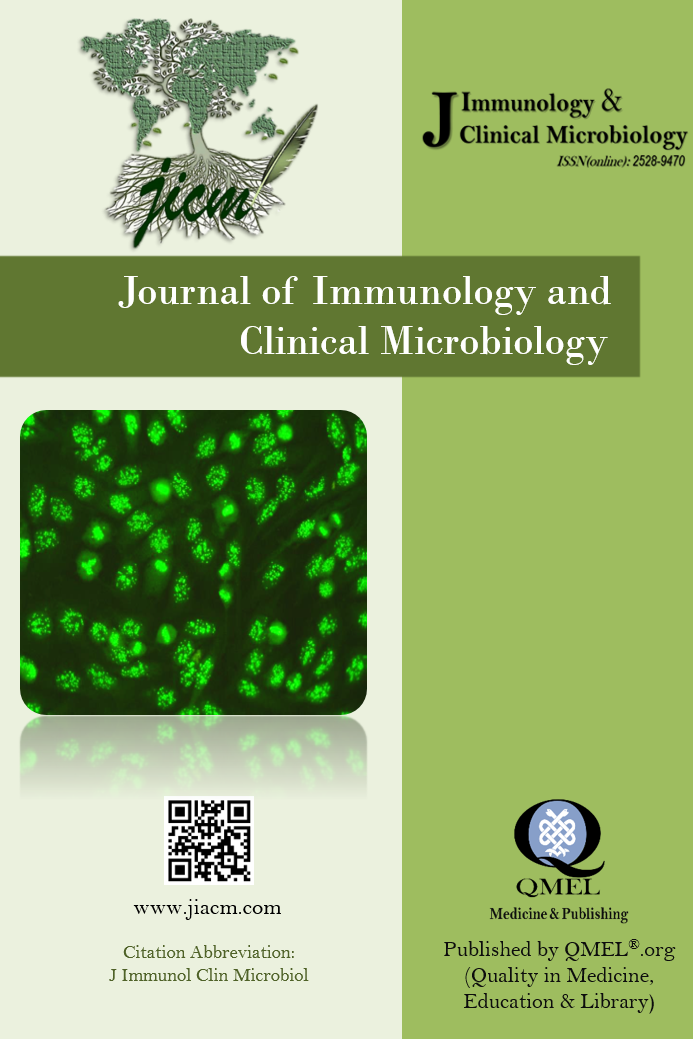Nöroloji Yoğun Bakım Ünitesinde Santral Venöz Kateter İle İlişkili Kan Dolaşım Enfeksiyonlarının Değerlendirilmesi
Santral venöz kateter enfeksiyonu, nöroloji, yoğun bakım
Evaluation of Central Venous Catheter-Related Blood Circulation Infections in Neurology Intensive Care Unit
santral venöz kateter enfeksiyonu, nöroloji yoğun bakım ünitesi, hastane enfeksiyonu central venous catheter infection, neurology intensive care unit, hospital acquired infection,
___
- 1) Lorente L, Henry C, Martín MM, Jiménez A, Mora ML. Central venous catheter-related infection in a prospective and observational study of 2,595 catheters. Crit Care. 2005; 9(6): 631-5.
- 2) Timsit JF, Baleine J, Bernard L, Calvino-Gunther S, Darmon M, Dellamonica J et al. Expert consensus-based clinical practice guidelines management of intravascular catheters in the intensive care unit. Ann Intensive Care. 2020;10(1): 118.
- 3) Gahlot R, Nigam C, Kumar V, Yadav G, Anupurba S. Catheter-related bloodstream infections. Int J Crit Illn Inj Sci. 2014; 4(2): 162-7.
- 4) Kıray S, Yıldırım D, Özçiftçi S, Akın Korhan E, Uyar M. Santral Venöz Kateter Bakımı ve Enfeksiyon: Bir Sistematik Derleme. J Turk Soc Intens Care. 2019; 17:60-74.
- 5) Incidence, risk factors, microbiology of venous catheter associated bloodstream infections - A prospective study from a tertiary care hospital M Kaur, V Gupta, S Gombar, J Chander, T Sahoo Indian Journal of Medical Microbiology, 2015 33(2): 248-254
- 6) Ak O, Batırel A, Ozer S, et al. Nosocomial infections and risk factors in the intensive careunit of a teaching and research hospital: A prospective cohort study. Med Sci Monit. 2011; 17: 29-34
- 7) Oncul A, Koculu S, Elevli K. Bir Devlet Hastanesi’nin yoğun bakım ünitelerinde kazanılan hastane enfeksiyonlarının epidemiyolojisi. Şişli Etfal Hastanesi Tıp Bülteni. 2012; 46: 61-2
- 8) Parameswaran R, Sherchan JB, Varma DM, Mukhopadhyay C,Vidyasagar S. Intravascular catheter-related infections in an Indian tertiary care hospital. J Infect Dev Ctries 2011; 5: 452-8
- 9) Apostolopoulou E, Raftopoulos V, Filntisis G, Kithreotis P, Stefanidis E, Galanis P, Veldekis D. Surveillance of device-associated infection rates and mortality in 3 Greek intensive care units. Am J Crit Care. 2013; 22(3): e12-20
- 10) Atilla, A , Doğanay, Z , Çelik, H , Demirağ, M , Kılıç, S . "Central line-associated blood stream infections: characteristics and risk factors for mortality over a 5.5-year period" . Turk J Med Sci.2017; 47: 646-652
- 11) Horan T, Andrus M, Dudeck MA. CDC/NHSN surveillance definition of health-care associated infection and criteria for specific types of infections in the acute care setting. Am J Infect Control 2008; 36(5): 309-332
- 12) Jackson SS, Leekha S, Magder LS, Pineles L, Anderson DJ, Trick WE, Woeltje KF, Kaye KS, Stafford K, Thom K, Lowe TJ, Harris AD. The Effect of Adding Comorbidities to Current Centers for Disease Control and Prevention Central-Line-Associated Bloodstream Infection Risk-Adjustment Methodology. Infect Control Hosp Epidemiol. 2017; 38(9): 1019-1024
- 13) O'Grady NP, Alexander M, Dellinger EP, Gerberding JL, Heard SO, Maki DG, Masur H, McCormick RD, Mermel LA, Pearson ML, et al.: Guidelines for the prevention of intravascular catheterrelated infections. Centers for Disease Control and Prevention. MMWR Recomm Rep 2002, 51:1-29.
- 14) O'Grady NP, Alexander M, Burns LA, Dellinger EP, Garland J, Heard SO, Lipsett PA, Masur H, Mermel LA, Pearson ML, Raad II, Randolph AG, Rupp ME, Saint S; Healthcare Infection Control Practices Advisory Committee (HICPAC). Guidelines for the prevention of intravascular catheter-related infections. Clin Infect Dis. 2011; 52(9): e162-93
- 15) Crump JA, Collignon PJ. Intravasculer associated infections. Eur J Clin Microbiol Infect Dis 2000; 19: 1-8.
- 16) Fraenkel DJ, Rickard C, Lipman J. Can we achieve consensus on central venous catheter-related infections?. Anaesth Intensive Care 2000; 28: 475-90
- Yayın Aralığı: Yılda 4 Sayı
- Başlangıç: 2016
- Yayıncı: Erkan YULA
The effects of balneotherapy on depression and anxiety scale scores in patients with osteoarthritis
Arzu DİNÇ YAVAŞ, Ebru UMAY, Mustafa TEZELLİ
Kısa Barsak Sendromunda Mikrobiyota ve Pre-Probiyotikler
Eftal GEÇGİL DEMİR, Fatma Bengü KUYULU BOZDOĞAN, Aybala TAZEOĞLU
COVID-19 Hastalarında İmmunokromatografik Antikor Testi Sonuçları
Evaluation on the correlation between gender and drug allergy agent and its incidence frequency
İzzet FİDANCI, Mert SATILMIŞ, Duygu AYHAN BAŞER, Hilal AKSOY, Duygu YENGİL TACİ, Mustafa CANKURTARAN
Peripheral Facial Paralysis After COVID-19 Vaccination
Ahmet DOĞAN, Hatun ÖZTÜRK ÇERİK, Atila GÜRGEN, Aykut ÖZTURAN
Zeynep TANRIVERDİ, Onur YİĞİTASLAN, Salih Atakan NEMLİ, Süreyya GÜL YURTSEVER, Esra BASKURT, Hatice TÜRE, Mehmet ÇELEBİSOY
